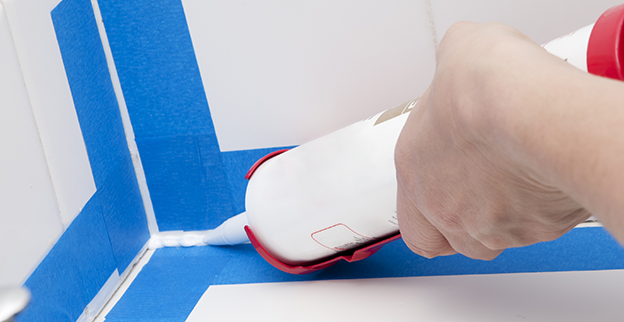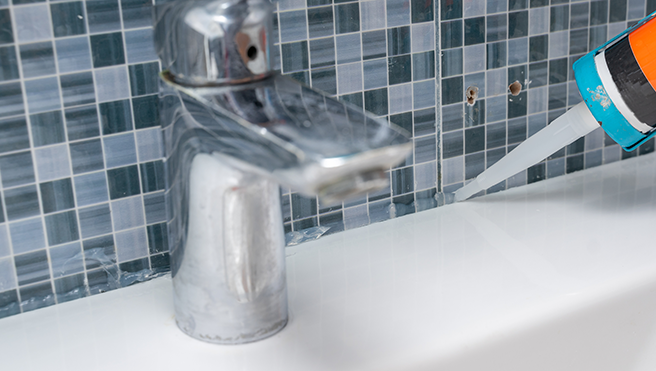As the potential areas where you might need caulking service can vary, the exact process Mr. Handyman uses for caulking service varies too. However, in most cases, you can expect your appointment for caulking service to include the following steps:
- Inspection: Before getting started, we’ll conduct a thorough inspection to determine the best type of caulking to use for your specific needs. We’ll also look for other damage that might need repairs as a result of missing or damaged caulking.
- Removal of Old Caulk: If necessary, we’ll carefully remove any old caulk, ensuring that no further damage is created.
- Application of New Caulk: After removing the old caulk and prepping the area for new caulk, we’ll carefully apply a new layer of caulk.
- Curing: After the caulking is complete, it may be necessary to allow up to 24 hours or longer for the caulk to cure completely before it is exposed to moisture, depending on the product used.
Because the exact circumstances of your project may vary, it’s never a bad idea to give our team a call and discuss the specifics with our caulking experts. The team at Mr. Handyman is happy to answer any questions you may have and provide you with a full estimate and inspection prior to proceeding with the caulking service.
Signs You Need Dallas Caulking Services:
It’s not always apparent when you need caulking services. Dallas, TX homeowners who need to re-caulk worn surface fillers may notice the following problems:
- Gaps between countertop and wall
- Gaps between the backsplash and countertop
- Discolored grout lines
- Loose window panes
- Loose caulk inside shower or bathtub
- Gaps in the door trim and jamb
- Cracked caulk where baseboards meet floors or walls
As a rule of thumb, any type of gap, crack, or dislodging between two materials poses a high risk of moisture and water damage that could lead to costly repairs, especially in humid areas like your bathroom or kitchen.
Bad caulking services around your door and window trim will lead to air leaks that will cause your HVAC system to become less energy efficient. For proper home caulking services, Dallas, TX handymen bring the right tools and knowledge to help you detect any serious issues that need to be addressed before they remove any faulty caulk and apply new beads.
Types of Caulking Products
As a highly reliant sealer and filler, caulk is a handy repair product to have in every household. Designed to withstand humidity and water, it is not indestructible, yet some types are more durable than others.
Acrylic Latex Caulk
The primary ingredients for this type include acrylic polymers, water, and latex. Sometimes additional fillers are added to increase the bonding resilience. It has the natural appearance of latex and sits well on irregular or porous surfaces. This type is widely used even by your local handyman. It’s sometimes referred to as a painter's caulk, ideally used indoors to fill minor wall gaps or seal trim connections. Acrylic latex sealants are also suited for painting applications, but not so much for fixing larger damage.
Silicone
As an elastomer, silicone caulk is more durable and heavy-duty than your standard acrylic latex. Silicone caulk is known for enhanced elasticity and flexibility and is able to bond various materials together, from metals to glass and ceramics. Silicone is highly effective in repairing cracks, providing additional protection with its flexible movement capabilities. This way, sealed surfaces are unlikely to break. This makes silicone the best choice for indoor and outdoor applications.
Acrylic Latex Vs. Silicone
Although both are efficient products there is slight variation in application. Acrylic caulk is typically preferred as a seam or gap filler that prevents air and water from entering materials. On the other hand, silicone is preferred as a binding product thanks to its elastic properties. That said, it still works perfectly in bathrooms and kitchens where humidity levels are exceptionally high.
Price-wise, acrylic latex is less expensive, and it dries faster than silicone. Both offer versatility and even have specialized varieties for different types of surfaces or environments. During an appointment for professional caulking services in Dallas, TX, our service technicians will assess your existing surface and apply the most suitable type for the required repair.
Polyurethane
Besides its silicone counterparts, polyurethane is another popular type that is frequently used. As a plastic material, it can exist in various other forms, and one of them is as a sealant or caulk. It’s extremely resilient and flexible while, at the same time, moisture- and chemical-resistant.
Silicone Vs. Polyurethane
Both are highly durable adhesive sealants, but silicone still gets the medal for being superior. Despite silicone’s faster bonding strength, it does not bond with paint. Thus, you cannot paint over it like you can with polyurethane. Since polyurethane is an organic polymer, it also works well on wooden materials, especially if they require painting. However, silicone works best if you plan to weatherproof your home and back your insulation system. Sealing around your door and window frames will protect you from unwanted air leaks.
The only downside to silicone is that it takes longer to dry than the others and during the drying period, it emits unpleasant chemical fumes, requiring you to fully air that space. Did we mention that high-quality silicone takes 1 to 10 days to cure properly? When hiring professional home caulking services, Dallas, TX homeowners can rest easy knowing that our team of experts will identify the root problem and provide the right caulking solution with their caulking guns.






